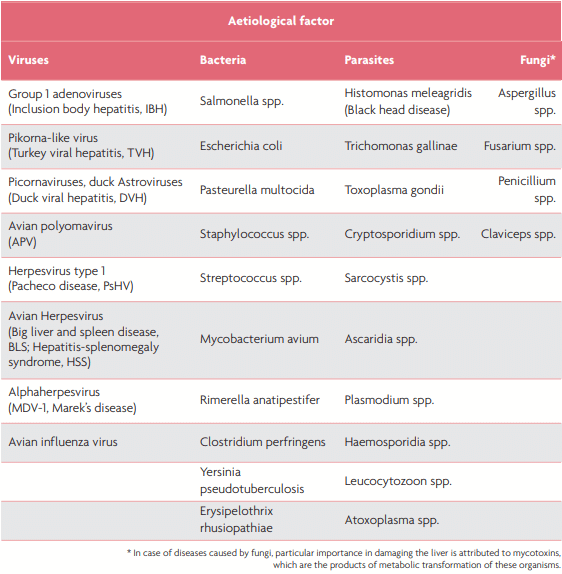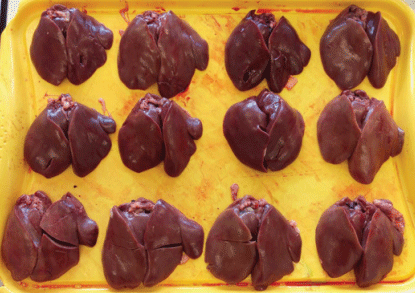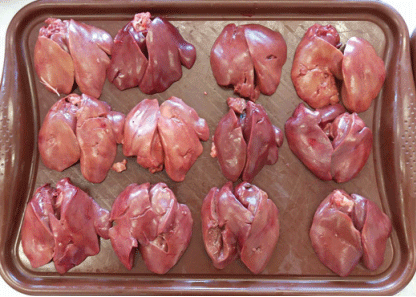Improving poultry health with the hepatoprotective effects of herbal extracts
Published: October 5, 2022
By: Albert Nakielski / Specialist of poultry diseases and ornamental birds, BioPoint, Poland. www.biopoint.eu.
Physiological aspects of the properly functioning digestive system and the organs directly related to it are at the heart of profitability in commercial poultry production. One of the most important organs in the body of every bird is the liver, and the complexity of functions it fulfills proves its unique significance.
This organ may be particularly vulnerable to damaging factors, which in turn can contribute to the reduction of production capacity of the flock and, in extreme cases, even to mass bird deaths.
Bird liver structure
The liver is one of the largest internal organs of birds. It consists of right and left lobes, lies in the caudal region of the body cavity, its distal end physiologically does not protrude beyond the keel and it is visible immediately after the removal of the abdominal wall.
In case of broilers and turkeys, the left lobe of the liver is divided into lateral and medial lobes and the right lobe may have numerous secondary lobes.
Both left and right lobes have their own portal veins and hepatic arteries. The gallbladder lies on the last of the above mentioned lobes and stores bile produced in the liver. It is filled with a greenish fluid, consisting in particular of water, bile salts and bile pigments. Bile is excreted at about 1ml/hour and enters the duodenum via cystic ducts.
Some birds, like pigeons, ostriches and parrots, do not have a gallbladder, while in others (penguins), the organ is extremely large. The colour and size of the liver depend on the species and may be affected by health or the direction of bird production. Immediately after hatching the liver has a light-cream colour, due to fats and glycogen stored in it. After the resorption of the yolk sac is complete, at about 6-7 day of the chick’s life, the liver turns darker, and after another week, it turns a cherry-brown colour characteristic of adult birds. The liver is thick, has a shiny, smooth surface, a homogeneous structure and slightly sharpened edges.
Liver functions
The previously mentioned exceptional uniqueness of the liver as an organ fulfilling many functions necessitates the division of its roles into four basic ones: metabolic, detoxification, storage and secretory.
The metabolic functions of the liver result from its close connection with the metabolism of sugars, proteins and lipids, i.e. the basic nutrients contained in the feed. It is in the liver that the metabolic pathways of carbohydrates, the exchange of galactose and fructose into glucose, and the buffering of blood glucose levels happen.
The excess of carbohydrates delivered to the body is transformed and stored by the liver into glycogen.
Glycogen may be re-catalysed to glucose in a situation of hunger or prolonged lack of access to food.
The transformation of fats entering the gastrointestinal tract is possible due to the presence of the previously described bile. Its components are responsible for the emulsification process that takes place in the lumen of the duodenum and includes the reduction of surface tension causing the split of fat drops into smaller ones.
Table 1. Selected pathogens related to liver damage and liver disorders in poultry.

Thanks to this function, the digestive enzymes secreted to the duodenum have a much larger contact area with the decomposed fat components.
After being transformed into basic nutrients, they are absorbed through the intestinal epithelium and used in the system for subsequent transformations.
Role of bile acids
A very important role of bile acids coming from the gallbladder together with bile, is their participation in the absorption of fat-soluble vitamins (A, D3, E, K) and the transformation of B vitamins (B1, B2, B3).
The slightly acidic bile (pH 5.5-6.0 in broilers) allows for the initial activation of pancreatic enzymes, dissociates alkaline content entering the duodenum, but also takes an active part in removing metabolites of antibiotics and heavy metal ions from the body.
In case of transformation of proteins entering the digestive tract of birds, the liver does not remain a passive organ. After the initial hydrolysis in the intestines, with the participation of proteases and peptidases, free amino acids are formed, entering the liver via the portal vein after absorption.
Depending on the physiological state of the body, free amino acids can be transported by peripheral circulation to the structures of tissues and organs; are a substrate for the synthesis of functional hormones, proteins, and plasma enzymes, blood clotting factors; or are catalysed-deaminated (in case of excess protein) to ammonia and ketone bodies.
Birds are an uricotelic animal, which means that nitrogen metabolites, such as ammonia, are transformed into less toxic uric acid. The liver also stores vitamins A, D, K and iron, which, together with previously mentioned elements of plasma, are used in hematopoietic processes.
Disturbances of liver function in birds
Changes in the structure, colour, size or shape of the liver may be visible during the course of many diseases: bacterial, viral, parasitic and even fungal and metabolic.
The most important tool in the diagnosis of liver diseases is histopathological examination. After viewing the changes under the microscope, it is usually possible to indicate the primary cause of liver dysfunction or to exclude probable damaging factors.
The most frequently recorded changes in the microscopic picture of the liver are: degeneration, necrosis or change in the shape of hepatocytes, infiltration of inflammatory cells in blood vessels and hepatic portal and bile areas, hyperplasia and proliferation of the bile duct carrying bile.
A few pathogens have a direct affinity to liver cells, thus being the cause of pathognomonic changes. In addition, changes in the organ visible during a histopathological examination are usually the result of the simultaneous effect of several damaging factors.
Therefore, isolating one pathogen as a cause of the disorder causes many difficulties.
Table 1 on the previous page indicates the aetiological factors in the course of which very often damage or change in the structure of the liver is observed.
Natural substances and liver functions
Herbs play a special role in the processes of liver regeneration and strengthening. They contain large amounts of flavonoids, phenolic acids, tannins, and other substances that show hepatoprotective effects.
Those effects are especially useful in liver protection against toxins and free radicals, but also in the regeneration of damaged cells and DNA fragments.
Fig. 1. Organs of the birds from Site 1.

Fig. 2. Organs of the birds from Site 2.

Milk Thistle (Sylibum marianum) seeds contain a set of substances called silymarin, the most abundant of which is silibinin. It is a substance with properties strongly reducing the effects of oxygen free radicals, which significantly damage hepatocytes. In addition, silibinin has been shown to modulate the effects of pro-inflammatory cytokines, limiting the occurrence of inflammation in the liver.
The globe artichoke (Cynara skolymus) is another plant with hepatoprotective properties. Artichoke contains large amounts of flavonoids and phenolic acids, among which the main role is played by cynarine. These substances affect the activation of DNA repair mechanisms, which have been damaged by toxins present in the liver. In addition, they improve the functioning of mechanisms reducing oxygen free radicals. Very similar properties are found in common dandelion (Taraxacum officinale) root extracts.
During studies using environmental toxins (for example sodium dichromate), it was shown that dandelion extracts protected animal liver DNA and stimulated the repair of damaged genetic material fragments.
The structure of hepatocytes was also unchanged in animals that received dandelion extract.
Stimulation of liver function and its protection should also be done with the use of organic chemicals and vitamins, along with the use of medicinal plants. The former include betaine and choline. Betaine is delivered to liver cells, where it regulates, among others, the production of an important amino acid – methionine. Betaine interacts with choline in the distribution of food lipids, thus, in addition to participating in digestion processes, it also helps to reduce fat deposits in the liver itself.
The role of vitamins
Vitamins, especially from group B, such as B1, B2, B6, play an extraordinary role in liver protection processes. They actively participate in the processes of metabolising sugars, fats and proteins, thereby regulating the main functions of the liver.
It is also recommended to use vitamin E in combination with selenium as a support for the body's anti-oxidant system. The combination of the aforementioned micronutrients with medicinal plants has a synergistic effect, including the neutralisation of free oxygen radicals, which are one of the most dangerous factors in damaging liver cells.
Field test
Ross 308 chicks used in the research were kept on a commercial farm in two identical facilities. Some 40,000 birds were placed in each facility. The prophylactic vaccination program, feed material and technological conditions in both facilities were identical.
For birds kept on Site 1, prophylactic administration of the hepatoprotective agent (Hepamix plus, by BioPoint) was introduced between the third and fifth week of the bird's life (four days in each week of the fattening process).
During organoleptic examination of the liver in the slaughterhouse, clear differences in the appearance and structure of the assessed organ were found. In the chickens coming from Site 1, the liver did not differ from the generally accepted norms for age and no symptoms of structural damage were observed (Fig. 1).
The organs isolated from birds from Site 2 were characterised by brittleness, changed colour, presence of boundary spots on the edges of liver lobes and disturbances in the liver parenchyma (Fig. 2).
This article was originally published in International Poultry Production • Volume 26 Number 7.
Related topics:
Authors:
BioPoint
Recommend
Comment
Share

Would you like to discuss another topic? Create a new post to engage with experts in the community.








.jpg&w=3840&q=75)